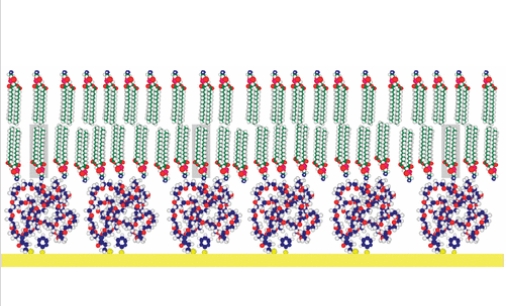DSPE-PEG-PDP辅助制备的柔性PEG垫层用于脂质双层膜重构研究
论文:聚乙二醇阻抗脂质双层玻璃在金表明的原位进行及表现链接代码://pubs.acs.org/doi/abs/10.1021/la048378o做者:杰弗里·C·芒罗,柯蒂斯·W·弗兰克提要:別人提供 ,在脂质两层线路膜和膏状表面上范围内增加整合物垫层,还可以出现软绵、可变气门正时形的膜层,关键在于保证跨膜淀粉酶的嵌入和转迁。本研究方案可以进行第二步吸收性过程中 ,在聚乙二醇 (PEG) 膜蛋白上出现了可转迁的、可约束的脂质两层线路膜。 PEG 聚酰亚胺膜是可以进行共吸收性异职能远爪 PEG 脂质整合物(1,2-二硬脂酰-sn-甘油-3-磷酸乙酸乙酯胺-N-聚(乙二醇)-2000- N- [3-(2-(吡啶基二硫代)丙酸酯])(DSPE-PEG-PDP)和非脂质职能化的 PEG-PDP 从乙酸乙酯/水混合型物中配制的,如之前的小论文(Munro,JC;Frank,CW Langmuir 2004,20,3339-3349)里面述。接下来选用二步脂质溶解对策。先要,将脂质从己烷溶剂中溶解到 PEG 媒介上。之后,将囊泡溶解并相结合在外层以在水学习环境中组成加厚。光洗白实验设计后的荧光修复表达,该期间制造吸附指数公式约为 2 μm /s。现在束搏脂质容重的新增,加厚膜的渗透率急剧减低。外层等亚铁离子体振动法(使在法检验原位膜厚薄)和荧光法(使在降钙素原检测法检验所有18 x 18直径样件的荧光抗压强度)也声明了加厚膜的组成,之所以几层成分。难过的是,荧光显微镜查检也界面显示样件上具备越大的缺陷报告,这的限制了该装置的趣味性强性。Abstract ImageInclusion of a polymer cushion between a lipid bilayer membrane and a solid surface has been suggested as a means to provide a soft, deformable layer that will allow for transmembrane protein insertion and mobility. In this study, mobile, tethered lipid bilayers were formed on a poly(ethylene glycol) (PEG) support via a two-step adsorption process. The PEG films were prepared by coadsorbing a heterofunctional, telechelic PEG lipopolymer (1,2-distearoyl-sn-glycero-3-phosphoethanolamine-N-poly(ethylene glycol)-2000-N-[3-(2-(pyridyldithio)propionate]) (DSPE-PEG-PDP) and a nonlipid functionalized PEG-PDP from an ethanol/water mixture, as described in a previous paper (Munro, J. C.; Frank, C. W. Langmuir2004, 20, 3339−3349). Then a two-step lipid adsorption strategy was used. First, lipids were adsorbed onto the PEG support from a hexane solution. Second, vesicles were adsorbed and fused on the surface to create a bilayer in an aqueous environment. Fluorescence recovery after photobleaching experiments show that this process results in mobile bilayers with diffusion coefficients on the order of 2 μm2/s. The mobility of the bilayers is decreased slightly by increasing the density of tethered lipids. The formation of bilayers, and not multilayer structures, is also confirmed by surface plasmon resonance, which was used to determine in situ film thickness, and by fluorimetry, which was used to determine quantitatively the fluorescence intensity for each 18 by 18 mm sample. Unfortunately, fluorescence microscopy also shows that there are large defects on the samples, which limits the utility of this system.



 pg电子娱乐游戏app
微信公众号
pg电子娱乐游戏app
微信公众号 官方微信
官方微信